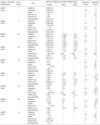1. Ubukata K. Problems associated with high prevalence of multidrug-resistant bacteria in patients with community-acquired infections. J Infect Chemother. 2003. 9:285–291.

2. Ubukata K, Iwata S, Sunakawa K. In vitro activities of new ketolide, telithromycin, and eight other macrolide antibiotics against Streptococcus pneumoniae having mefA and ermB genes that mediate macrolide resistance. J Infect Chemother. 2003. 9:221–226.

3. Inoue M, Lee NY, Hong SW, Lee K, Felmingham D. PROTEKT 1999-2000: a multicentre study of the antibiotic susceptibility of respiratory tract pathogens in Hong Kong, Japan and South Korea. Int J Antimicrob Agents. 2004. 23:44–51.

4. Roberts MC, Sutcliffe J, Courvalin P, Jensen LB, Rood J, Seppala H. Nomenclature for macrolide and macrolide-lincosamide-streptogramin B resistance determinants. Antimicrob Agents Chemother. 1999. 43:2823–2830.

5. Hasegawa K, Chiba N, Kobayashi R, Murayama SY, Iwata S, Sunakawa K, Ubukata K. Rapidly increasing prevalence of beta-lactamase-nonproducing, ampicillin-resistant Haemophilus influenzae type b in patients with meningitis. Antimicrob Agents Chemother. 2004. 48:1509–1514.
6. Morosini MI, Canton R, Loza E, del Campo R, Almaraz F, Baquero F. Streptococcus pyogenes isolates with characterized macrolide resistance mechanisms in Spain: in vitro activities of telithromycin and cethromycin. J Antimicrob Chemother. 2003. 52:50–55.

7. Farrell DJ, Morrissey I, Bakker S, Felmingham D. Molecular characterization of macrolide resistance mechanisms among Streptococcus pneumoniae and Streptococcus pyogenes isolated from the PROTEKT 1999-2000 study. J Antimicrob Chemother. 2002. 50:Suppl S1. 39–47.

8. Sunaoshi K, Nakayama E, Kobayashi R, Suzuki E, Tajima T, Ubukata K. Antibiotic susceptibility and T type identification of Streptococcus pyogenes isolated from pediatric outpatients with pharyngotonsillitis. Jpn J Chemother. 2004. 52:401–407.
9. Ubukata K, Chiba N, Hasegawa K, Kobayashi R, Iwata S, Sunakawa K. Antibiotic susceptibility in relation to penicillin-binding protein genes and serotype distribution of Streptococcus pneumoniae strains responsible for meningitis in Japan, 1999 to 2002. Antimicrob Agents Chemother. 2004. 48:1488–1494.

10. Lina G, Quaglia A, Reverdy ME, Leclercq R, Vandenesch F, Etienne J. Distribution of genes encoding resistance to macrolides, lincosamides, and streptogramins among staphylococci. Antimicrob Agents Chemother. 1999. 43:1062–1066.

11. Ross JI, Eady EA, Cove JH, Cunliffe WJ, Baumberg S, Wootton JC. Inducible erythromycin resistance in staphylococci is encoded by a member of the ATP-binding transport super-gene family. Mol Microbiol. 1990. 4:1207–1214.
12. Schmitz FJ, Petridou J, Milatovic D, Verhoef J, Fluit AC, Schwarz S. In vitro activity of new ketolides against macrolide-susceptible and -resistant Staphylococcus aureus isolates with defined resistance gene status. J Antimicrob Chemother. 2002. 49:580–582.

13. Canton R, Loza E, Morosini MI, Baquero F. Antimicrobial resistance amongst isolates of Streptococcus pyogenes and Staphylococcus aureus in the PROTEKT antimicrobial surveillance programme during 1999-2000. J Antimicrob Chemother. 2002. 50:Suppl S1. 9–24.
14. Okubo T, Iyobe S, Fujiki Y, Sagai H. Antimicrobial activities of macrolides against recent clinical isolates, and analysis of resistant mechanisms. Jpn J Antibiot. 2003. 56:163–170.
15. Hsueh PR, Teng LJ, Wu TL, Yang D, Huang WK, Shyr JM, Chuang YC, Wan JH, Yan JJ, Lu JJ, Wu JJ, Ko WC, Chang FY, Yang YC, Lau YJ, Liu YC, Lee CM, Leu HS, Liu CY, Luh KT. Telithromycin and fluoroquinolone-resistant Streptococcus pneumoniae in Taiwan with high prevalence of resistance to macrolides and beta-lactams: SMART program 2001 data. Antimicrob Agents Chemother. 2003. 47:2145–2151.
16. Peric M, Bozdogan B, Jacobs MR, Appelbaum PC. Effects of efflux mechanism and ribosomal mutations on macrolide susceptibility of Haemophilus influenzae clinical isolates. Antimicrob Agents Chemother. 2003. 47:1017–1022.
17. Sanchez L, Pan W, Vinas M, Nikaido H. The acrAB homolog of Haemophilus influenzae codes for a functional multidrug efflux pump. J Bacteriol. 1997. 179:6855–6857.








 PDF
PDF ePub
ePub Citation
Citation Print
Print


 XML Download
XML Download